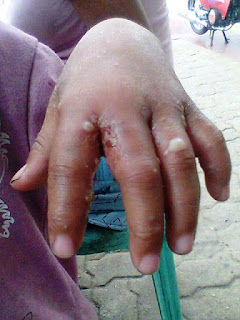Following are among the diseases common to children living on the street.
 |
| Skin Diseases |
 |
| A child's infected hand |
 |
| Sore Eyes due to viral infection |
Sore Eyes is the inflammation of the thin covering of the eyeball and inner eyelid. The inflammation is brought on by a viral, bacterial, or allergy infection. Extremely contagious, it spreads easily by eye to hand to eye contact,a
runny nose or cough, or when people come into contact with a contaminated surface or object. If severe enough or long lasting, it can eventually lead to corneal scarring that can cause glare and decreased vision. Experts recommend not going to work or school if you have sore eyes or symptoms of sore eyes until symptoms are relieved and treatment is successful.

runny nose or cough, or when people come into contact with a contaminated surface or object. If severe enough or long lasting, it can eventually lead to corneal scarring that can cause glare and decreased vision. Experts recommend not going to work or school if you have sore eyes or symptoms of sore eyes until symptoms are relieved and treatment is successful.

Sore Eyes Symptoms
- Redness of the eyes
- Discomfort
- Burning
- Gritty sensation
- Photophobia (sensitivity to light)
- Pain
- Difficulty opening eyes after sleeping
- Eyelids stuck together after sleeping
- Water-like discharge
- Soreness
- Runny nose
- Sore throat
- Lymph glands are sore (lymph glands are your body’s defensive filter, they are located behind the ears)
 |
| Sty |

Due to lack of medicine for sore eyes, our RN gives one droplet medicine for at least 3 to 5 children knowing that droplets must be administered every after 2 hours.She advised the parents to bring their children to the nearest clinic if possible.
 Eczema which is also called dermatitis.
Eczema which is also called dermatitis. 

